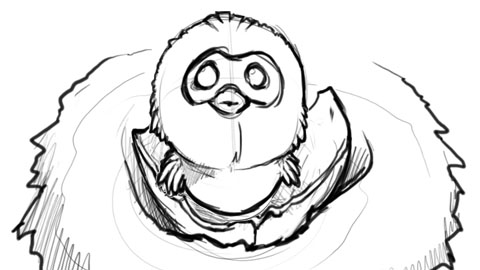Awaken |
|
| Latest News | Trailer | Gallery | Press Kit | Credits | Behind-The-Scenes | |
Storyboarding
Once the script is finalised the entire film is storyboarded. Rather than use pencil and paper, we drew all the storyboard panels directly on the computer using Photoshop and a Wacom tablet. This allowed us to reuse common elements, such as trees, clouds, etc in different panels.
All the storyboard panels were brought into a video editing package so that basic timing could be determined. With the panels split into multiple parts (background, characters, props), simple 2D animation could be applied. This gave the shots a more dynamic result and allowed the basic composition and timing to be worked out.
The resulting film from the edit is called an animatic, and it goes through many, many revisions to ensure that the entire film functions as a whole.

Previsualisation
Despite its long name, previsualisation is actually quite simple. This is the first stage where the film enters the 3D realm. The characters, props, and sets are first modelled and then rigged. These elements are then brough into a 3D scene, where a camera is added to view the action. The characters are animated in a very basic pose-to-pose fashion. This allows the character's action to be blocked out quickly without getting bogged down in fine animation details. For example, a character's walk won't be animated but instead they will slide across the scene.
Previsualisation is about flexibility and speed. Its purpose is to produce a first pass blocking of every shot in the film. The shots are quickly edited together into a rough version of the film. The general pacing of the film becomes clear at this stage and as a result some shots will extended while others will be shortened. New shots will be progressively added, while some existing shots removed. The more refining that can be done during previsualisation the less work in the more costly and time-consuming following stages.
Animation
After previsualisation, each shot will contain characters with basic blocking animation. This animation is progressively refined, starting with the posing of the major parts of the body (pelvis, spine, legs, and arms). After many iterations, the timing of these poses is more precisely defined. Work continues from the major parts to the minor parts, such as fingers, toes, etc. Overlapping and secondary action are applied after the major parts are completed.
Special attention is paid to ensuring that the character moves with a sense of weight and force. Facial animation is completed last with small refinements such as eye darts, blinks, hair movements, etc added at this final stage.
Final Lighting & Rendering
The characters, sets, and props are textured then brought into the lighting scene. Often a basic rig will be created that provides the initial setup for each scene. In this film, a lot of the action happens outdoors during the middle of the day. Particular attention is paid to ensuring lighting ratios are respected. The sun casts hard shadows that are softened by the bounce light from the sand.
Rendering the scene includes taking into account all the lights, shadows, and other optical effects such as motion blur and depth of field.
The scene is rendered into multiple passes: background, mid-ground, and characters. These are then later composited together to produce the final images.